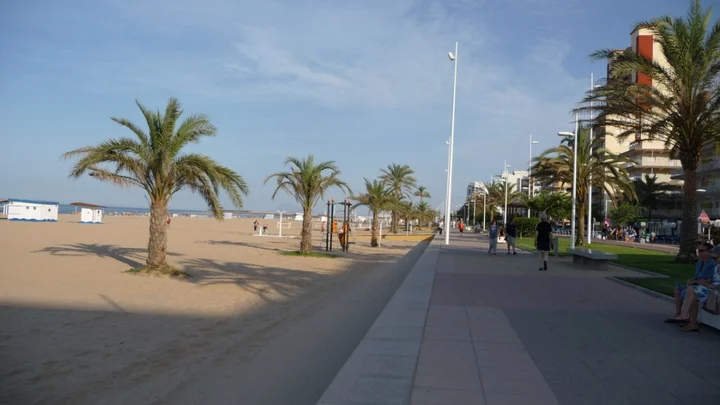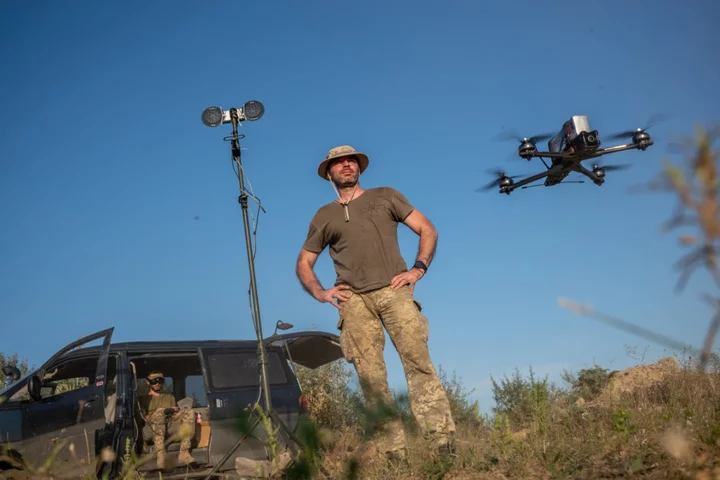
Asean Latest: Chinese Premier Makes Debut as Tensions Mount
Chinese Premier Li Qiang is set to make his international debut in Jakarta at the Southeast Asia forum
1970-01-01 08:00

Oil Tests November High After OPEC+ Leaders Extend Supply Cuts
Oil held near the highest since November after OPEC+ leaders Saudi Arabia and Russia announced that they would
1970-01-01 08:00

SoftBank’s Arm Seeks to Raise Up to $4.87 Billion in Anticipated IPO
SoftBank Group Corp.’s Arm Holdings Ltd. is planning to raise as much as $4.87 billion in the chip
1970-01-01 08:00

Child dies after entering water at Irish beach
Irish police say a young girl has died after she entered the water at a beach in County Cork.
1970-01-01 08:00

French schools send ‘dozens’ of Muslim girls home over traditional robe
French state schools have sent “dozens” of Muslim girls home for wearing a traditional robe banned in educational settings last week. The French education minister reported that almost 300 pupils arrived at school on Monday wearing the abaya, a long, loose over-garment that spans from the shoulders to the feet. Similar to the djellaba worn in North Africa or the qamis which is popular in West Africa, it is largely worn by women. Official figures reflect that 298 girls, mostly aged 15 and over, wore the garment to school in spite of the ban, most of whom agreed to change their clothes after being reprimanded by teachers. However, 67 girls refused to comply with the rules and were sent home. Now, they face further discussions between their schools and families; should they refuse to obey, they could face exclusion. Education minister Gabriel Attal announced the ban at the end of August in line with France’s secularist ban on religious signs in state schools and government buildings. For Mr Attal, the garments are “an infringement on secularism” and, in some cases, a bid to destabilise schools. Elsewhere, pupils and teachers alike have been banned from wearing a headscarf in state-run schools since 2004, and full-face veils have been banned in public since 2010. The rules also include the Jewish kippa. France has a long history of secularism, having enforced strict bans on religious imagery in schools since the 19th century to curb Catholic influence on public education. Critics of the new policy argue that abayas, worn by women, and khamis, the male garb, are no more than a fashion statement. They say the garments do not constitute an ostentatious sign of religion and should not be banned from classrooms under a 2004 law. Authorities fear that religious symbols are a gateway to Islamic radicalism, while some Muslims feel stigmatised by efforts to make them conform. Islam is the second largest religion in France. “Our schools are continually tested. We know that,” Mr Attal said at a news conference a week ahead of the start of the school year. He said that the wearing of abayas and khamis, a “new phenomenon,” has recently grown, and must be met with a firm response to tackle what sometimes amounts to “infringements, attempts at destabilisation.” Read More France set to ban Muslim students from wearing abaya in state schools French education minister bans long robes in classrooms in effort to defend nation's secular values France's Macron says schools will be 'intractable' in enforcing ban on robes often worn by Muslims France's Macron supports experimenting with uniforms in some schools amid debate over ban on robes
1970-01-01 08:00

Zoom CEO Says FTC Should Look at Microsoft Teams Bundle After EU Investigation
Zoom Video Communications Inc. Chief Executive Officer Eric Yuan said the US Federal Trade Commission should look into
1970-01-01 08:00

Irish police chief in Dubai to discuss criminal gangs
Gardaí say Commissioner Drew Harris is to attend a series of meetings as part of an ongoing operation.
1970-01-01 08:00

Police detect 865 drivers speeding on 'Slow Down Day'
Irish police say they observed 865 drivers speeding over the course of 24-hours.
1970-01-01 08:00

Tourists horrified after human leg washes up on popular Spanish beach
Tourists were left horrified after a human leg was found washed up on a popular Spanish beach. A human leg and part of a hip were discovered by a passerby walking along the seashore in the east coast resort of Gandia. The woman spotted an object in the sand and dug it out with a stick before calling emergency services, Spanish newspaper informacion.es reported. A full investigation is now underway to identify the victim and their cause of death. Police believe the remains may have come from someone on board a ship that was transporting people from North Africa to Europe, according to Las Provincias. It is not known exactly where the ship was headed to, but police believe it may have been travelling to Spain or Italy. Las Provincias also reported an autopsy has been carried out, that confirmed the remains had been in the water for three weeks, citing a document from the Forensic Anatomical Institute of Valencia. Police believe the leg and hip, which were in an advanced state of decomposition, were detached from the body due to the impact of the sea. “As everything indicates that the leg was detached from the body due to the strong waves, given that it is entire from hip to ankle, it is likely that there are other remains of the body in the sea,” a source from the investigation said, Las Provincias reported. The area where the remains were found has now been sealed off. A search is also being carried out to find the rest of the corpse. Read More Shark attacks swimmer in shallows of popular Spanish holiday beach Fifteen people a day attacked by fish in Benidorm as people with moles warned Fisherman airlifted to hospital after shark bite off coast of Portugal
1970-01-01 08:00

Orsted Ready to Abandon US Wind Projects as It Asks for Help
Orsted A/S said it’s prepared to walk away from projects in America unless the White House guarantees more
1970-01-01 08:00

Drone warfare map reveals how Ukraine is striking Russia hundreds of miles from the frontline
As drone strikes continue to rain down on Russian soil, Vladimir Putin’s bloody war has reached his own doorstep. The strikes are now daily and on Tuesday the Russian defence ministry said its air defence systems destroyed two drones over the Kaluga and Tver regions, which border the Moscow region, as well as one closer to the capital, over the Istra district. Moscow Mayor Sergei Sobyanin said that the drones “were trying to carry out an attack on Moscow“ and that a consumer services facility was damaged in the Istra district, which is located some 65 km (40 miles) northwest of the Kremlin. Attacks on Russia have increased sharply, with the largest such strikes hitting six regions on one night last week. That assault included two Russian military transport planes being destroyed – and two more damaged – at an airbase in the city of Pskov. Ukraine’s military intelligence chief, Kyrylo Budanov, said that the drones were launched from inside Russia. However, in speaking to the War Zone website, Mr Budanov did not say whether the attack – about 400 miles (700km) from the Ukraine border – was carried out by Ukrainian or Russian operatives. “We are working from the territory of Russia,” he said. Officials confirmed attacks on six targets in the Pskov, Bryansk, Kaluga, Orlov, Ryazan and Moscow regions. Meanwhile, Moscow has continued to carry out drone attacks on Ukrainian targets including port infrastructure. On Monday, 32 Russian kamikaze drones struck the Ukrainian port city of Odesa, damaging civilian and industrial buildings. The assault on the military airfield in Pskov that damaged aircraft has been deemed the most significant attack, situated more than 600km (400 miles) from Ukraine, it was where a number of elite paratroopers are stationed. The state-run Tass news agency reported at least four giant Il-76 transport planes were damaged in the four-hour wave of drones, two of which had “burst into flames”. Moscow retaliated on Wednesday by launching a “massive combined attack” on the Ukrainian capital using drones and missiles, that killed two people and injured another. Kyiv officials normally neither claim nor deny responsibility for attacks on Russian soil, though they sometimes refer obliquely to them. The apparent Ukrainian drones reaching deep into Russia and cross-border sabotage missions are part of Kyiv’s efforts to heap domestic pressure on the Kremlin, militarily and politically. Meantime, a Ukrainian counteroffensive launched in June is chipping away at some parts of the front line, Kyiv officials claim. Read More The Body in the Woods | An Independent TV Original Documentary The harrowing discovery at centre of The Independent’s new documentary Ukraine war – live: Putin accused of trafficking Cubans to fight for Russia in his invasion The three reasons Putin will be terrified of Ukraine’s counteroffensive win Kim Jong-un to hold weapons talks with Putin after ‘travelling to Russia in armoured train’
1970-01-01 08:00

Niger Junta Expects Rapid French Troop Withdrawal Amid Talks
Niger’s ruling junta said discussions are under way that are expected to result in the rapid withdrawal of
1970-01-01 08:00
